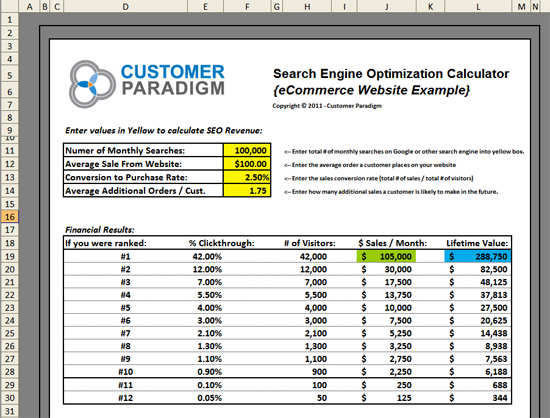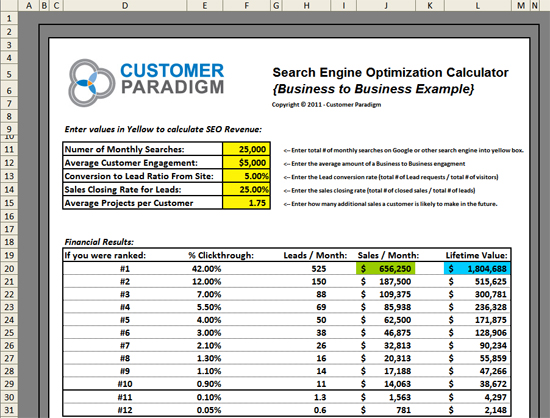|
 What What
Are Search Engine Optimization Results Worth?
On
average, the #1 top search result in Google receives
42% of the clickthroughs from a search results
page.
The
#2 result gets about 12% of the clicks. By the
time you reach the third, fourth and fifth results,
the clickthrough rates drop to about 3%.
If
you’re not on page one, for most search users,
you may as well not exist. Clickthrough rates
for #11-20, for example, range in the 0.5% clickthrough
rate.
Research
shows that consumers trust the natural search
results the most. Sponsored ads (Cost Per Click)
receive between 0.05% – 2% clickthrough rates,
depending your position and ad copy.
So
what does this mean to a website? Part of it depends
on how you value a visitor to your website, and
how many people are searching for specific keyword
terms that your site is ranked for.
Business
to Consumer eCommerce Example:
If
you have a Business to Consumer eCommerce site,
and you have an average order of $100, and a 2.5%
conversion to purchase, here’s an example of how
much revenue you can expect as a direct result
of search engine rankings.
If
2.5% of your visitors make a purchase, the #1
top result is worth 1,050 purchases x $100 average
order = $105,000 per month in sales. The #8 spot
will generate only $3,250 in revenue.
A
page 2 result, where you receive 0.05% means that
you’ll likely have only 100 visitors to the site.
At a 2.5% conversion rate, that means you’ll have
approximately 2.5 sales, or revenue of $250.
SEO
Variables (Inputs):
|
Search
Volume:
|
100,000
searches per month for the keyword term |
|
Average
Order:
|
$100 |
Conversion
Rate: |
2.5% |
SEO
Expected Results:
|
Search
Rank:
|
#
of Visitors: |
$
Sales per month |
Lifetime
Value: |
|
#1
|
42,000 |
$105,000 |
$288,750 |
| #2 |
12,000 |
$30,000 |
$82,500 |
| #3 |
7,000 |
$17,500 |
$48,125 |
| #11 |
100 |
$250 |
$688 |
SEO
Match Spreadsheet:
I’ve
put together a spreadsheet that can help you do
this SEO math, and it’s available for download
from our site:

SEO
Excel Spreadsheet Calculator for B2C eCommerce
Site –
Visit Here to Download >>
SEO
Web-based Calculator for B2C eCommerce Site >>
Add
Lifetime Customer Value to the Equation:
If
you factor in lifetime customer value into the
equation (how much money a single customer will
spend with you through your organization), the
numbers keep getting better.
For
example, if you expect that each new customer
will place 1.5 more orders during the next two
years, your lifetime customer value of that search
engine result jumps from $105,000 to $288,750
in expected sales from that monthly timeframe.
Business
to Business Example:
For
non-ecommerce sites, the same basic logic applies.
Instead of what your average order, try to place
an economic value on what a new lead might be
(i.e. $2,500), and what you normally see for your
closing rate.
I’ve
put together an Excel Spreadsheet that will help
you understand how to do this calculation, too:
 Download Download
Excel Spreadsheet B2B SEO Optimization Calculator
— Visit Here >>
SEO
Web-based Conversion-to-Lead Calculator for B2B
Site >>
How
to Determine Keyword Volume:
To
determine how many people are searching for specific
keyword terms, Google has put together a keyword
search tool >>
(More advanced features are included if you are
a Google Adwords CPC advertiser.)
Keys
to Figuring Out Metrics:
The
key to figuring out these metrics is understanding:
How much are people actually searching for keywords
that are important to you?
What is your conversion to purchase rate on
your site?
What is your average order value?
What is your lifetime customer value ratio?
How do you rank for high-volume search terms
in different search engines?
How much more money could you be making if you
jump up in the search engines?
|

